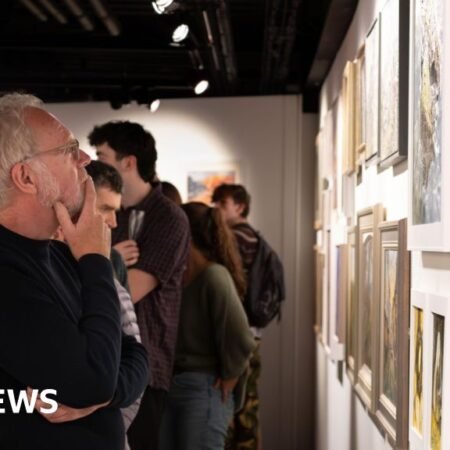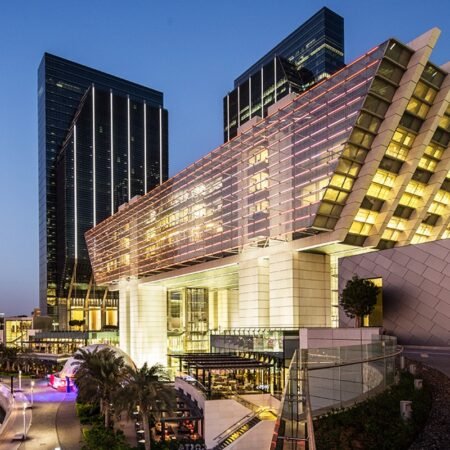This week in Newly Reviewed, Jillian Steinhauer covers E.E. Ikeler’s cosmic diagrams, Veronica Ryan’s resolute casualness, and Tega Brain and Sam Lavigne’s climate change interventions.
Lower East Side
E.E. Ikeler
Through Nov. 16. Essex Flowers, 19 Monroe Street; essexflowers.us.
Looking at E.E. Ikeler’s paintings feels a bit like looking at the internet — if the internet were tactile and more pastel. To even call these works “paintings” seems a bit misleading: For as much acrylic as they contain, they’re also full of cast tiles, 3-D printer filament and collage elements.
When you step back and take them in whole, they suggest cosmic diagrams or the creations of an obsessive teenager. When you get up close, any overarching imagery dissolves into snippets of Google search results, memes and personal photos embedded into the surface.
Ikeler, who lives in Brooklyn, has long made paintings in which smaller elements coalesce into larger patterns. But as the title of the current show, “Horror Vacui,” suggests, these are among Ikeler’s busiest yet. They may also be the most personal.
“Zodiac Them” (all works 2025) depicts a zodiac chart overlaid on a Vitruvian Man-like figure. Circles around the perimeter feature images and avatars of Ikeler and references to their life, amounting to a partly genuine and partly cheeky statement of queer identity.
In “Self-Made Man” and “Hero’s Journey,” cartoonish drawings of the artist in a baseball cap navigate spaces filled with printed snippets of queer history and conspiracy theories. The terrain is filled with collaged and painted rectangles and mini mosaics of handmade tiles — game boards crossed with treasure maps, perhaps. Ikeler is on a quest to find some kind of personal truth in a culture filled with absurdity and deception. The artist’s feat is making it look so fun.
Chelsea
Veronica Ryan
Through Nov. 22. Paula Cooper Gallery, 521 West 21st Street; 212-255-1105, paulacoopergallery.com.
With their stringently white walls and harsh lighting, most galleries are inhospitable. So I noticed when I walked into Veronica Ryan’s show “Retrieval” that I immediately felt invited. Soft materials abound, including fabric poufs and doilies, and the many sculptures dotting the space are human scaled. The exhibition feels approachable.
Partly this is because Ryan uses found objects that any viewer can recognize, like water bottles; she may fill them with Himalayan salt and wrap them in crochet webbing or cast them in ceramic. But the sense of openness has just as much to do with the overall installation. Ryan groups objects as if they were having conversations, or places them in unexpected spots, as with two long pendants hanging in a corner near the entrance.
Her work may look easy, but its casualness is resolutely cultivated. The British artist, born in Montserrat, won the Turner Prize in 2022, at age 66, but had been working for decades beforehand without being widely known.
Many of the threads of her practice coalesce in “Archaeology of the Black Sun 1956-2002” (2003), an installation of hundreds of small objects hung across several walls. Some items — a tea strainer, say — are simply themselves. Others have been manipulated, like a leather cushion studded with nails or a baking dish stuffed with grimy, yellowing pads.
Some arrangements are funny; others feel totemic or mournful. “Archaeology” manifests a care born from attention, but also the type of vigilance that comes from need. It consists of the very basics of life, turned into poetry and mapped like a constellation.
Brooklyn
Tega Brain and Sam Lavigne
Through Dec. 14. Pioneer Works, 159 Pioneer Street, Brooklyn; 718-596-3001, pioneerworks.org.
Much discussion of climate change revolves around buzzy concepts like “net zero” and “carbon offsets.” But how effective are those things, really? This is one of the questions raised by Tega Brain and Sam Lavigne’s thought-provoking exhibition “How to Get to Zero.”
The centerpiece is a collaborative project called “Offset” (2025). The artists have created a marketplace where you can buy carbon offsets whose proceeds go to people committing acts of climate-related sabotage, like disruption of the Dakota Access Pipeline — or the killing of the UnitedHealthcare C.E.O. Brian Thompson, an inclusion that’s in highly questionable taste. (The money goes toward Luigi Mangione’s defense on murder charges.) An accompanying video with dry voice-over and whimsical visuals lays out Brain and Lavigne’s methodology for calculating their offsets, which is modeled after those of the carbon industry itself.
The other showstopper is “Cold Call” (2025), which features three stations with computers and headsets where you can call fossil fuel industry executives. The goal is to keep them on the line as long as possible as a form of “time theft”; to that end, the software offers conversational help, like poems. I chickened out but listened to recordings of previous calls (mostly but not entirely voice mail).
I have aesthetic critiques of Brain and Lavigne’s art, but the flaws are offset (pun intended) by its audacity. They don’t pretend that participating in their prompts will save the world, but refreshingly, they also refuse to relinquish agency. They recognize the ridiculousness of working within a highly flawed system, but retain enough sincerity to try and challenge it.
See the October gallery shows here.








No Comment! Be the first one.